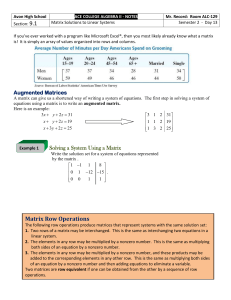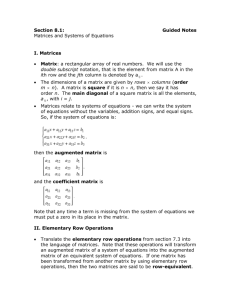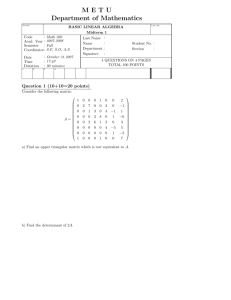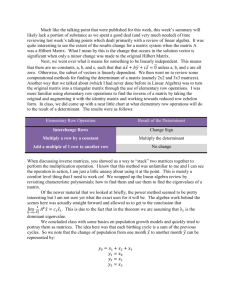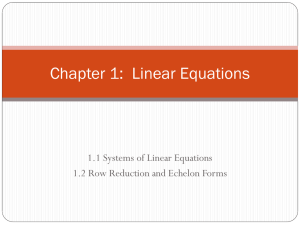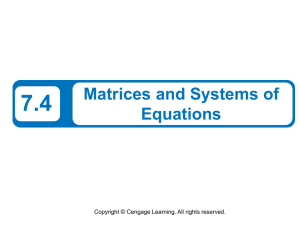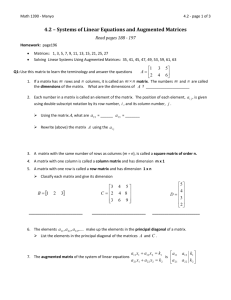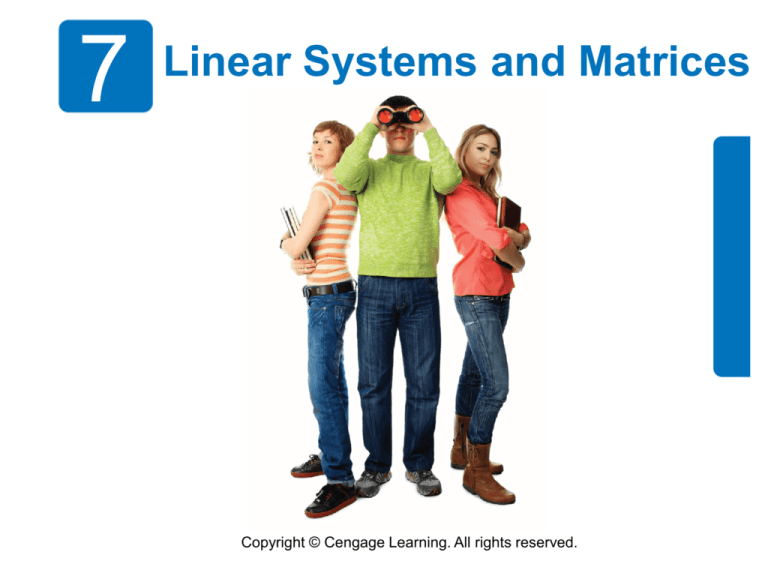
7
Linear Systems and Matrices
Copyright © Cengage Learning. All rights reserved.
7.4
Matrices and Systems of
Equations
Copyright © Cengage Learning. All rights reserved.
What You Should Learn
•
•
•
•
Write matrices and identify their dimensions.
Perform elementary row operations on
matrices.
Use matrices and Gaussian elimination to solve
systems of linear equations.
Use matrices and Gauss-Jordan elimination to
solve systems of linear equations.
3
Matrices
4
Matrices
In this section, you will study a streamlined technique for
solving systems of linear equations.
This technique involves the use of a rectangular array of
real numbers called a matrix.
The plural of matrix is matrices.
5
Matrices
6
Matrices
The entry in the i th row and j th column is denoted by the
double subscript notation aij.
For instance, the entry a23 is the entry in the second row
and third column.
A matrix having m rows and n columns is said to be of
dimension m n. If m = n then the matrix is square of
dimension m n (or n n).
For a square matrix, the entries
a11, a22, a33, …
are the main diagonal entries.
7
Example 1 – Dimension of a Matrix
Determine the dimension of each matrix.
a. [2]
b.
d.
e.
c.
8
Example 1 – Solution
a. This matrix has one row and one column. The
dimension of the matrix is 1 1.
b. This matrix has one row and four columns. The
dimension of the matrix is 1 4.
c. This matrix has two rows and two columns. The
dimension of the matrix is 2 2.
d. This matrix has three rows and two columns. The
dimension of the matrix is 3 2.
e. This matrix has three rows and one column. The
dimension of the matrix is 3 1.
9
Matrices
A matrix that has only one row [such as the matrix in
Example 1(b)] is called a row matrix, and a matrix that has
only one column [such as the matrix in Example 1(e)] is
called a column matrix.
A matrix derived from a system of linear equations (each
written in standard form with the constant term on the right)
is the augmented matrix of the system.
Moreover, the matrix derived from the coefficients of the
system (but not including the constant terms) is the
coefficient matrix of the system.
10
Matrices
The matrix derived from the constant terms of the system is
the constant matrix of the system.
System:
x – 4y + 3z = 5
– x – 3y – z = –3
2x
– 4z = 6
Augmented Matrix:
11
Matrices
Coefficient Matrix:
Constant Matrix:
12
Matrices
Note the use of 0 for the missing coefficient of the
y-variable in the third equation, and also note the fourth
column (of constant terms) in the augmented matrix.
The optional dotted line in the augmented matrix helps to
separate the coefficients of the linear system from the
constant terms.
13
Example 2 – Writing an Augmented Matrix
Write the augmented matrix for the system of linear
equations.
x + 3y = 9
–y + 4z = –2
x – 5z = 0
What is the dimension of the augmented matrix?
14
Example 2 – Solution
Begin by writing the linear system and aligning the
variables.
x + 3y
= 9
– y + 4z = –2
x
– 5z = 0
Next, use the coefficients and constant terms as the matrix
entries. Include zeros for the coefficients of the missing
variables.
15
Example 2 – Solution
cont’d
The augmented matrix has three rows and four columns,
so it is a 3 4 matrix.
The notation Rn is used to designate each row in the
matrix. For instance, Row 1 is represented by R1.
16
Elementary Row Operations
In matrix terminology, these three operations correspond to
elementary row operations.
An elementary row operation on an augmented matrix of a
given system of linear equations produces a new
augmented matrix corresponding to a new (but equivalent)
system of linear equations.
Two matrices are row-equivalent when one can be
obtained from the other by a sequence of elementary row
operations.
17
Elementary Row Operations
18
Example 3 – Elementary Row Operations
a. Interchange the first and second rows of the original
matrix.
Original Matrix
New Row-Equivalent Matrix
b. Multiply the first row of the original matrix by
Original Matrix
New Row-Equivalent Matrix
19
Example 3 – Elementary Row Operations cont’d
c. Add –2 times the first row of the original matrix to the
third row.
Original Matrix
New Row-Equivalent Matrix
Note that the elementary row operation is written beside
the row that is changed.
20
Gaussian Elimination with Back-Substitution
The next example demonstrates the matrix version of
Gaussian elimination.
The basic difference between the two methods is that with
matrices we do not need to keep writing the variables.
21
Example 4 – Comparing Linear Systems and Matrix Operations
Linear System
Associated Augmented Matrix
x – 2y + 3z = 9
–x + 3y + z = – 2
2x – 5y + 5z = 17
Add the first equation to the
second equation.
Add the first row to the
second row: R1 + R2.
x – 2y + 3z = 9
y+ 4z = 7
2x – 5y + 5z = 17
22
Example 4 – Comparing Linear Systems and Matrix Operations
Add –2 times the first
equation to the third
equation.
x – 2y + 3z = 9
y + 4z = 7
–y– z=–1
cont’d
Add –2 times the first row to the
third row: –2R1+R3
Add the second equation to
the third equation.
Add the second row to the
third row: R2 + R3.
x – 2y + 3z = 9
–x + 3y + z = –2
2x – 5y + 5z = 17
23
Example 4 – Comparing Linear Systems and Matrix Operations
Multiply the third equation by
cont’d
Multiply the third row by
x – 2y + 3z = 9
y + 4z = 7
z=2
At this point, you can use back-substitution to find that the
solution is
x = 1, y = –1, and z = 2.
24
Gaussian Elimination with Back-Substitution
The last matrix in Example 4 is in row-echelon form.
The term echelon refers to the stair-step pattern formed by
the nonzero elements of the matrix.
25
Gaussian Elimination with Back-Substitution
To be in this form, a matrix must have the following
properties.
26
Example 5 – Row-Echelon Form
Determine whether each matrix is in row-echelon form. If it
is, determine whether the matrix is in reduced row-echelon
form.
a.
b.
c.
d.
27
Example 5 – Row-Echelon Form
e.
cont’d
f.
Solution:
The matrices in (a), (c), (d), and (f) are in row-echelon form.
The matrices in (d) and (f) are in reduced row-echelon form
because every column that has a leading 1 has zeros in
every position above and below its leading 1.
28
Example 5 – Solution
cont’d
The matrix in (b) is not in row-echelon form because the
row of all zeros does not occur at the bottom of the matrix.
The matrix in (e) is not in row-echelon form because the
first nonzero entry in Row 2 is not a leading 1.
29
Gaussian Elimination with Back-Substitution
Gaussian elimination with back-substitution works well for
solving systems of linear equations by hand or with a
computer.
For this algorithm, the order in which the elementary row
operations are performed is important.
We should operate from left to right by columns, using
elementary row operations to obtain zeros in all entries
directly below the leading 1’s.
30
Example 6 – Gaussian Elimination with Back-Substitution
Solve the system of equations.
y + z – 2w = –3
x + 2y – z
=2
2x + 4y + z – 3w = –2
x – 4y – 7z – w = –19
Solution:
Write augmented matrix.
31
Example 6 – Solution
cont’d
Interchange R1 and R2
so first column has
leading 1 in upper left
corner.
Perform operations
on R3 and R4 so first
column has zeros below
its leading 1.
32
Example 6 – Solution
cont’d
Perform operations on
R4 so second column
has zeros below its
leading 1.
Perform operations
on R3 and R4 so third
and fourth columns
have leading 1’s.
33
Example 6 – Solution
cont’d
The matrix is now in row-echelon form, and the
corresponding system is
x + 2y – z
= 2
y + z – 2w = – 3
z– w=–2
w= 3
Using back-substitution, you can determine that the
solution is
x = –1, y = 2, z = 1, w = 3.
Check this in the original system of equations.
34
Gaussian Elimination with Back-Substitution
The following steps summarize the procedure used in
Example 6.
35
Gauss–Jordan Elimination
With Gaussian elimination, elementary row operations are
applied to a matrix to obtain a (row-equivalent) row-echelon
form of the matrix.
A second method of elimination, called Gauss-Jordan
elimination after Carl Friedrich Gauss (1777–1855) and
Wilhelm Jordan (1842–1899), continues the reduction
process until a reduced row-echelon form is obtained.
This procedure is demonstrated in Example 8.
36
Example 8 – Gauss–Jordan Elimination
Use Gauss-Jordan elimination to solve the system.
x – 2y + 3z = 9
– x + 3y + z = – 2
2x – 5y + 5z = 17
Solution:
In Example 4, Gaussian elimination was used to obtain the
row-echelon form
37
Example 8 – Solution
cont’d
Now, rather than using back-substitution, apply additional
elementary row operations until you obtain a matrix in
reduced row-echelon form.
To do this, you must produce zeros above each of the
leading 1’s, as follows.
Perform operations on R3 so
second column has a zero
above its leading 1.
38
Example 8 – Solution
cont’d
Perform operations on R1 and
R2 so third column has zeros
above its leading 1.
The matrix is now in reduced row-echelon form.
Converting back to a system of linear equations, you have
x= 1
y = –1
z= 2
39
Example 8 – Solution
cont’d
Now you can simply read the solution,
x = 1, y = –1, z = 2
which can be written as the ordered triple (1, –1, 2).
You can check this result using the reduced row-echelon
form feature of a graphing utility, as shown in Figure 7.23.
Figure 7.23
40

